
The Automobil-Verkehrs- und Übungsstraße, known as AVUS, is a public road in Berlin, Germany. Opened in 1921, it was also used as a motor racing circuit until 1998. Today, the AVUS forms the northern part of the Bundesautobahn 115.

A straight-four engine is a four-cylinder piston engine where cylinders are arranged in a line along a common crankshaft.
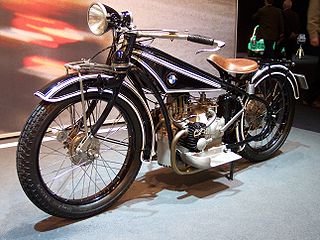
BMW's motorcycle history began in 1921 when the company commenced manufacturing engines for other companies. BMW's own motorcycles—sold under the BMW Motorrad brand—began in 1923 with the BMW R 32, which was powered by a flat-twin engine. Production of motorcycles with flat-twin engines continues to this day, however BMW has also produced many models with other types of engines.

In automotive engineering a multi-valve or multivalve engine is one where each cylinder has more than two valves. A multi-valve engine has better breathing and may be able to operate at higher revolutions per minute (RPM) than a two-valve engine, delivering more power.

A motorcycle engine is an engine that powers a motorcycle. Motorcycle engines are typically two-stroke or four-stroke internal combustion engines, but other engine types, such as Wankels and electric motors, have been used.

The motorcycle land-speed record is the fastest speed achieved by a motorcycle on land. It is standardized as the speed over a course of fixed length, averaged over two runs in opposite directions. AMA National Land Speed Records requires 2 passes the same calendar day in opposite directions over a timed mile/kilo while FIM Land Speed World Records require two passes in opposite directions to be over a timed mile/kilo completed within 2 hours. These are special or modified motorcycles, distinct from the fastest production motorcycles. The first official Fédération Internationale de Motocyclisme (FIM) record was set in 1920, when Gene Walker rode an Indian on Daytona Beach at 104.12 mph (167.56 km/h). Since late 2010, the Ack Attack team has held the motorcycle land speed record at 376.36 mph (605.69 km/h).

The AJS V4 started out as a prototype air-cooled V4 road bike, but became a water-cooled and supercharged racing bike.

Ernst Jakob Henne was a German motorcycle racer and racecar driver.
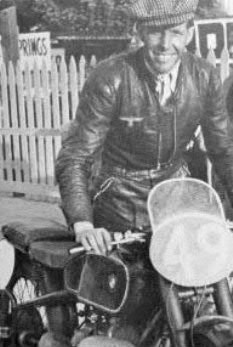
Georg "Schorsch" Meier was a German motorcycle racer famous for being the first foreign winner of the prestigious Senior TT, the Blue Riband race of the Isle of Man TT Races, in 1939 riding for the factory BMW team and the first motorcycle racer to lap a Grand Prix course at over 100 mph.

G-Power is a German car tuning manufacturer based in Aichach, Bavaria. Founded in 1983 by Jochen Grommisch, the company specialises in tuning BMW cars and manufacturing boutique vehicles. Its supercharged 5.0L V-10 830 hp BMW M5 Hurricane RRS reached 372 km/h (231 mph)
BMW Motorrad is the motorcycle brand and division of German automotive manufacturer, BMW. It has produced motorcycles since 1923, and achieved record sales for the fifth year in succession in 2015. With a total of 136,963 vehicles sold in 2015, BMW registered a growth of 10.9% in sales in comparison with 2014. In May 2011, the 2,000,000th motorcycle produced by BMW Motorrad was an R1200GS.
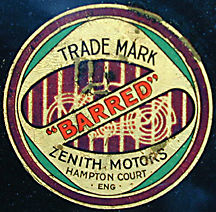
Zenith Motorcycles was a British motorcycle and automobile manufacturer established in Finsbury Park, London in 1903, by W.G. Bowers. Automobile manufacture only lasted from 1905–1906. The first Zenith motorcycle was the 'BiCar' of 1903, based on Tooley's Bi-Car design, which was purchased by Zenith for its own production. The BiCar was a unique design with hub-center steering and a low-slung chassis with the engine centrally fixed.
The Magic Midgets were a number of record-breaking 750cc "midget" MG cars of the 1930s. They were most notably, but not always, driven by George Eyston.
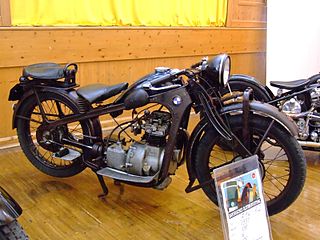
The BMW R2 was a 198 cc overhead valve single-cylinder motorcycle produced by BMW between 1931 and 1936, the smallest motorcycle ever to enter series production with the firm. Despite its much smaller design and engine capacity, the R2 retained many features of the larger boxer twin motorcycles in the range, such as cardan shaft drive and a pressed-steel duplex frame. The R2 was the smallest in the range of singles produced during the 1930s by BMW, with its big brothers being the 305 cc R3 and the 400 cc R4.
Forced induction in motorcycles is the application of forced induction to a motorcycle engine. Special automotive engineering and human factors considerations exist for the application of forced induction with motorcycles, compared to other forms of motorized transportation.
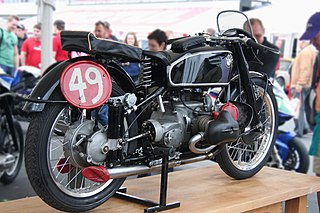
BMW Type 255 Kompressor was a supercharged boxer twin race motorcycle from the 1930s. A BMW 255 Kompressor was ridden to victory by Georg Meier in the 1939 Isle of Man TT and the first win by a non-British competitor in the premier 500cc Senior TT class. A similar BMW 255 Kompressor machine was auctioned in 2013 for US$480,000, the second-highest price ever paid at auction for a motorcycle.

The Kawasaki Ninja H2 is a "supercharged supersport"-class motorcycle in the Ninja sports bike series manufactured by Kawasaki, featuring a variable-speed centrifugal supercharger.

The Alpina B5 (E60) is the first generation of the Alpina B5 high performance executive car manufactured by German automobile manufacturer Alpina from 2005 to 2011. Based on the BMW 5 Series (E60), the car was available in saloon and wagon bodystyles. The car succeeds the Alpina B10.
The Shorrock supercharger was an eccentric sliding-vane type engine supercharger patented by James Haydock and Christopher Shorrock in 1933. Originally known as the Centric supercharger, it was widely used by engine tuners in the UK in the 1930s and in the 1950 and 1960s.
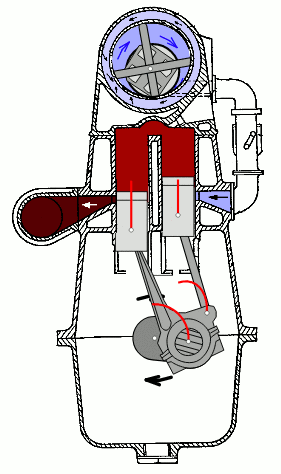
The Zoller supercharger was a vane-type supercharger created by Arnold Zoller (1882-1934) who had patents regarding supercharging engines before WW1. The Zoller supercharger was popular in the 1920s and 1930s.
















